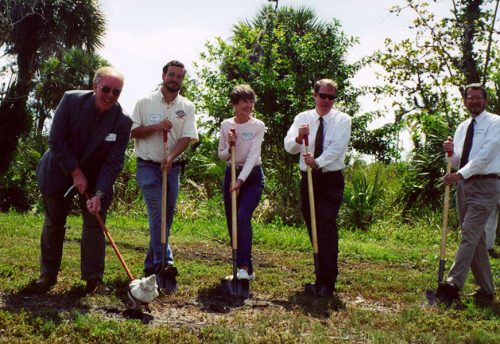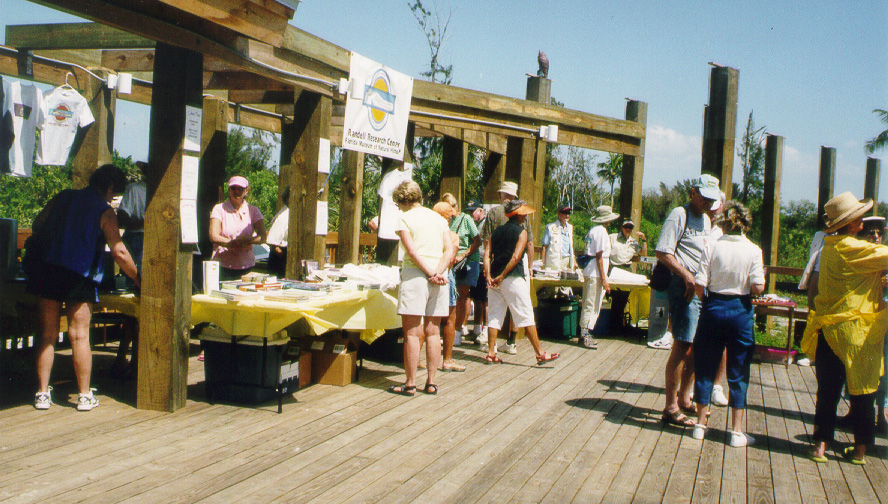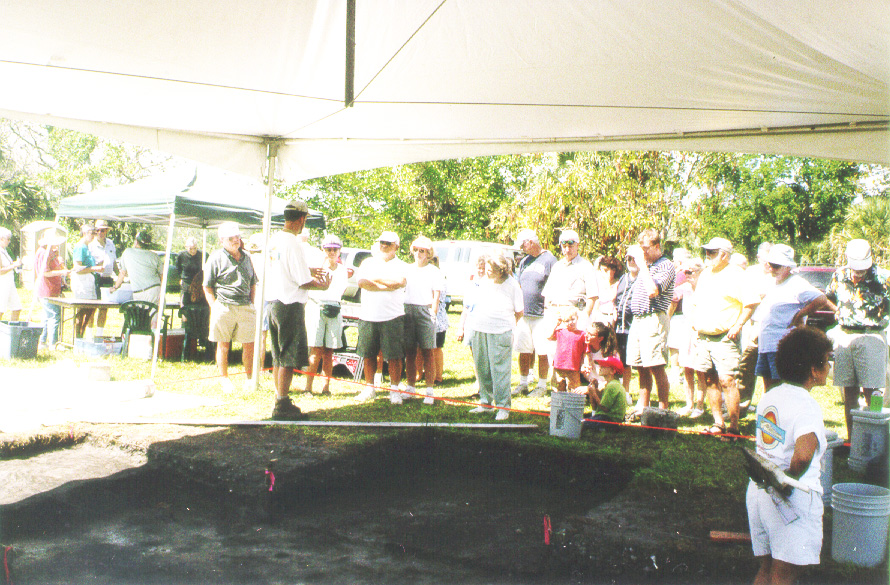As part of our celebration of the RRC’s 25th anniversary last year, we invited Bill Marquardt, RRC’s co-founder and first director, to summarize some of the key events in its history.

In the most recent newsletter, I wrote about the beginning of archaeological research at Pineland, the support of the Randell family, our research and learning programs in the early 1990s, and the decision of the Randells to gift 53 acres of their property to establish a permanent facility. I also tried to convey our awakening sense of how important the facility could be in bringing awareness of southwest Florida’s environment to the public, young and old, many of whom were new to the area.
The plan all along was for the Randells to donate the land to the University Foundation (the Foundation), which would hold the property until it could be bought by the County or the State. The Florida Museum’s RRC would manage the property for research and education, and the money gained from the sale of the property would go into an endowment fund. Then the interest income from the endowment would help pay for site maintenance and the beginning of a permanent staff.
When the Randells had owned the property, a small herd of cattle had roamed the pastures, munching happily on the grass. The good folks at the The Foundation decided that the cows would have to go. “Bill, the Foundation is not in the ranching business,” I was politely informed. So the Randells sold the cows, and the pasture grass, liberated at last, began to grow higher. And higher. The cost to mow was over $500 each time, and our meager stash of funds started to shrink. Until the property could be bought, there was no endowment income. Someone needed to be our local representative, leading tours, raising awareness, soliciting donations, and managing the prolific vegetation. I was needed in Gainesville to help with the permanent museum exhibit and to continue to edit and oversee production of our books and videos. What could we do? I begged for help from my Museum, and in 1998 Bill Keegan, then chair of the Museum’s academic department, offered a 3-year part-time salary to pay a local manager, Corbett Torrence. The rest of our budget went to mowing and the rental of a chemical toilet.
Corbett knew the site well because he had made the map of the site during the “Year of the Indian” project. A charismatic teacher, he hosted tours for both adults and school kids and inspired a team of volunteers to help keep the vegetation in check on the mounds and pathways (see Calusa News no. 10, pp. 2-3 for a summary – all project newsletters are available on-line on the RRC’s website). Corbett also assisted Karen Walker in her excavations on Useppa Island in November 1998. To raise awareness of the Calusa and the RRC, in 1999 and 2000 we hosted a “Calusa Festival” at Royal Palm Plaza. These events, as well as many public talks by Corbett and me, got the word out to both residents and tourists. Also in 1999, our monograph on the archaeology and history of Useppa Island was published. In May-June 2000, an archaeological field school from FGCU worked on top of Randell Mound 1, recording information from the footer holes that had been dug in preparation for house construction before the property was bought by the state (Calusa News no. 9, p. 3).
In the late 1990s an advisory board made up of local people and archaeological professionals began meeting to discuss ways to develop teaching facilities at the site that would be effective yet would not distract from the natural beauty of the landscape. We conceived of a visitor center with a classroom, a book and gift shop, and restrooms. Planning and design services were generously donated by Jeff Mudgett, Tim Keene, Dick Workman, and Bob Rude. In 2000, the Stans Foundation granted $105,000 toward the facility and other private gifts added $36,000. With a State match, we had $282,000 for the first phase: a parking lot, a handicapped-accessible ramp and deck, the restrooms, and a book and gift shop.
In November 2000, Lee County purchased the Ruby Gill House and post office, as well as about 8.5 acres of environmentally sensitive wetlands. The Gill House was slated to become the RRC’s headquarters and laboratories. The “Friends of the RRC” support society was founded, and the Maple Hill Foundation granted $230,000 to be allocated over a 5-year period for operating expenses while we raised money for an endowment. Following a national search, John Worth was hired on August 31 to manage the RRC, a new position funded by the Florida Museum. The advisory board adopted a five-year strategic plan in December 2001.
The following three years were eventful. The first issue of the RRC Friends newsletter was sent out in March 2002. The State Historic Preservation division granted $300,000 toward site interpretation at Pineland. Dwight and Sue Sipprelle pledged $100,000 to sponsor an interpretive trail. Meanwhile, in October the Museum’s long-awaited Hall of South Florida opened in Gainesville. Planning and design had begun in 1994 for the first permanent exhibit featuring South Florida in the Museum’s history. Much of the archaeological and environmental content was based on what we had learned at Pineland and elsewhere.
In 2002, archaeological excavations were completed in the area where our visitor center would be built. We purchased furniture and lab equipment for the Gill House, and a dedicated volunteer team built a comparative collection of animal bones and shells (RRC News vol. 1, no. 2). John Worth did archival work in Spain and Cuba on Spanish documents (RRC News vol. 1, no. 4) and in 2003 he began new volunteer- assisted excavations in Pineland’s south pasture. We completed the planning for the interpretive trail and Synergy Design Group began designing the trail signs.
We broke ground for the visitor center in April 2003. The same year, Karen Walker and Donna Surge began work on an NSF-sponsored study of climate change using archaeological clam shells and fish otoliths. On July 31, Don and Pat Randell’s wish was finally fulfilled: the State bought the gift properties from the Foundation for a little over $600,000, and in 2004 the State matched with $420,000. Both sums went into the endowment fund.
By March 2004, the first phase of construction was complete – the parking lot, ramp, restrooms, and pilings for the classroom. Preparations for the interpretive trail began – a sturdy bridge over the canal was built, an observation platform atop Brown’s Mound was assembled, and gravel trails were laid down in anticipation of the signs. John resumed the dig in the South Pasture, discovering evidence of structures more than 1500 years old. On March 21 we hosted our third “Calusa Festival” – this time not in a Cape Coral shopping center but right on our own, brand-new pavilion with many displays and tours of the excavations.
By summer 2004, the new interpretive signs had been installed. We planned a public grand opening for September. It was a heady time. Many people had worked hard, overcoming many obstacles. Now at last, thanks to the property sale, our first million had been raised for the endowment. The Museum had allocated a permanent position for a site manager. The first phase of interpretive facilities was completed. Hundreds had shown up for our first public event at the new pavilion. Membership in our support society was growing. We were doing exciting archaeological and historical research. We had functioning offices, a meeting room, and labs at the Gill House. But then came Friday the thirteenth of August.
On that day the northern end of Pine Island absorbed a direct hit from a powerful, fast-moving Category 4 hurricane. Our new pavilion, built to resist sustained winds of 155 mph, survived just fine, but our headquarters house and the site itself suffered severe damages. Thus on August 14, 2004, we began a new phase: the slow, laborious, and expensive process of recovering from the ravages of Charley. Although the times were tough, the RRC ultimately not only recovered but rebuilt stronger than ever. I’ll relate some of these stories in the next installment.
More
- A Brief History of the Randell Research Center, Part 1: 1988-1996
- A Brief History of the Randell Research Center, Part 3: 2004-2023
This article was taken from the Friends of the Randell Research Center Newsletter Vol 21, No. 1 & 2. November 2022.

